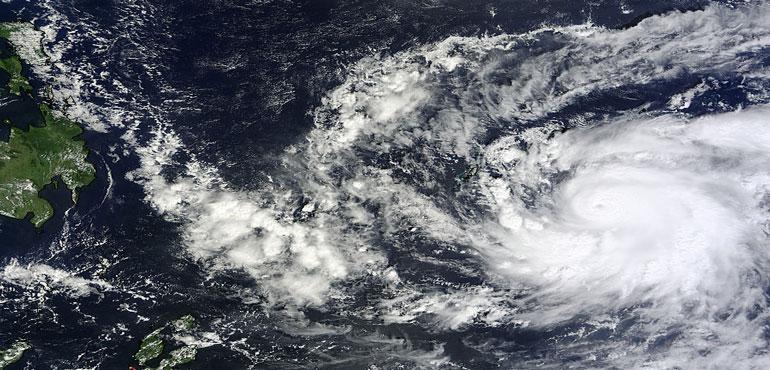Back to forecast
On This Day in 2012: Super Typhoon Bopha Impacts The Philippines
December 2, 2020 at 10:20 AM EST
By WeatherBug's Chris Sayles

On this day in 2012, Super Typhoon Bopha made landfall in the Philippines, becoming one of the most catastrophic typhoons to impact the island nation.
Late in the tropical cyclone season, the cluster of thunderstorms that would eventually don the name “Bopha” was first discovered well east of the Philippines in the central Pacific on November 23, 2012. From there, the once disorganized area of storms would intensify into a well-organized disturbance by November 25.
The storm would alarm the locals as the Japan Meteorological Agency (JMA) and the Joint Typhoon Warning Center (JTWC) would deem the storm a tropical depression later that day. The favorable environment of warm, tropical waters and low wind shear would allow the system to reach tropical storm status, thus given the name “Bopha” as a result.
Tropical Storm Bopha was expected to travel westward towards the Philippine Peninsula, but it stalled. This stalling motion on November 26 allowed the storm extra time to absorb more energy and intensify. It would not be until the 28th when the storm would begin its westward movement, and radar indicated thunderstorms embedded in the system would raise alarms for further strengthening to occur. It would only take the storm until the 30th to intensify into a typhoon with estimated winds of 75 mph.
By December 3, Bopha intensified into a super typhoon with estimated winds of 161 mph, dubbing it a Category 5 cyclone on the Saffir-Simpson Hurricane Wind Scale. Super Typhoon Bopha would make landfall across the southern Philippines on Dec. 3, 2012, devastating the surrounding islands. Tropical rainfall and powerful winds swept the region, causing damages to homes, buildings and even laying waste to entire villages. Bopha would be responsible for the lost of nearly 2,000 people with damages over $1 billion reported.
As Bopha approached the Philippines, it would be given the name “Pablo” by the Philippine Atmospheric, Geophysical and Astronomical Services Administration (PAGASA). Due to the utter devastation caused by the powerful super typhoon, the names “Pablo” and “Bopha” were retired in 2013.
Sources: nasa.gov, wikipedia.org
Story Image: The MODIS instrument on NASA's Terra satellite captured this visible image of Super Typhoon Bopha approaching the Philippines on Dec. 2, 2012 at 0145 UTC (Dec. 1 at 7:45 p.m. EST). (NASA/MODIS Rapid Response Team)
Late in the tropical cyclone season, the cluster of thunderstorms that would eventually don the name “Bopha” was first discovered well east of the Philippines in the central Pacific on November 23, 2012. From there, the once disorganized area of storms would intensify into a well-organized disturbance by November 25.
The storm would alarm the locals as the Japan Meteorological Agency (JMA) and the Joint Typhoon Warning Center (JTWC) would deem the storm a tropical depression later that day. The favorable environment of warm, tropical waters and low wind shear would allow the system to reach tropical storm status, thus given the name “Bopha” as a result.
Tropical Storm Bopha was expected to travel westward towards the Philippine Peninsula, but it stalled. This stalling motion on November 26 allowed the storm extra time to absorb more energy and intensify. It would not be until the 28th when the storm would begin its westward movement, and radar indicated thunderstorms embedded in the system would raise alarms for further strengthening to occur. It would only take the storm until the 30th to intensify into a typhoon with estimated winds of 75 mph.
By December 3, Bopha intensified into a super typhoon with estimated winds of 161 mph, dubbing it a Category 5 cyclone on the Saffir-Simpson Hurricane Wind Scale. Super Typhoon Bopha would make landfall across the southern Philippines on Dec. 3, 2012, devastating the surrounding islands. Tropical rainfall and powerful winds swept the region, causing damages to homes, buildings and even laying waste to entire villages. Bopha would be responsible for the lost of nearly 2,000 people with damages over $1 billion reported.
As Bopha approached the Philippines, it would be given the name “Pablo” by the Philippine Atmospheric, Geophysical and Astronomical Services Administration (PAGASA). Due to the utter devastation caused by the powerful super typhoon, the names “Pablo” and “Bopha” were retired in 2013.
Sources: nasa.gov, wikipedia.org
Story Image: The MODIS instrument on NASA's Terra satellite captured this visible image of Super Typhoon Bopha approaching the Philippines on Dec. 2, 2012 at 0145 UTC (Dec. 1 at 7:45 p.m. EST). (NASA/MODIS Rapid Response Team)